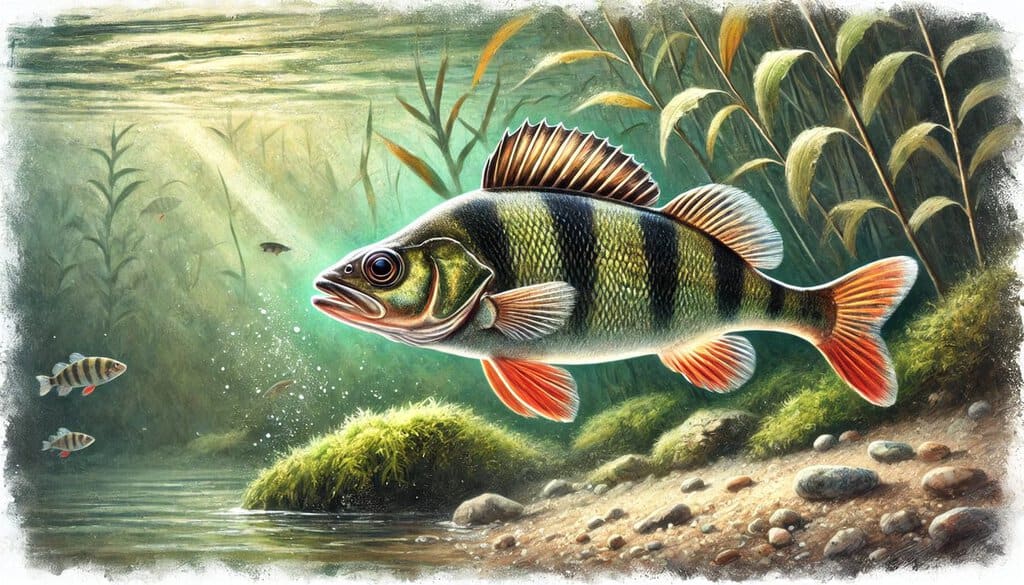European Perch is a popular species for aquaponics due to its adaptability and high-quality flesh. This freshwater fish is known for its resilience and ability to thrive in various aquatic environments[2]. Its popularity in aquaponics stems from its relatively fast growth rate and tolerance to a range of water conditions, making it suitable for both novice and experienced aquaponics practitioners.
Natural Habitat and Behavior
Origin and native environment
European Perch is native to Eurasia, inhabiting a wide range of habitats from estuarine lagoons to lakes and medium-sized streams[2]. It can be found in depths ranging from 1 to 30 meters (3.3 to 98.4 feet), but usually prefers depths of 3 to 4 meters (9.8 to 13.1 feet)[2].
Natural behavior in the wild
In the wild, European Perch is an opportunistic diurnal feeder, primarily active during sunrise and sunset[2]. Larvae and small juveniles typically feed on planktonic invertebrates, while adults often prey on fish once they reach about 12 cm (4.7 inches) in length[2].
Temperament
European Perch can be somewhat aggressive, especially during breeding seasons. In aquaponics systems, they may exhibit territorial behavior.
Compatibility
Due to their potential aggression, it’s best to keep European Perch with similar-sized fish and in species-specific tanks.
Water Requirements
Temperature Range
The ideal temperature range for European Perch is 10°C to 22°C (50°F to 71.6°F)[2]. They can tolerate a wider range, but optimal growth occurs within this range.
pH Level
European Perch prefer a pH range of 7.0 to 7.5[2]. They can tolerate slight fluctuations, but maintaining a stable pH is crucial for their health and growth.
Water hardness
This species prefers moderately hard water, with a dH range of 8 to 12[2].
Oxygen Levels
European Perch require well-oxygenated water. It’s recommended to maintain dissolved oxygen levels at 5 ppm or higher in aquaponics systems[3].
Ammonia/Nitrate Sensitivity
European Perch is sensitive to ammonia and nitrite. The ammonia level should be kept below 0.3 mg N-NH3 L−1 and nitrite below 0.5 mg N-NO2 L−1[4]. Regular monitoring and maintaining efficient biological filtration are essential to prevent toxicity issues.
Tank or Pond Setup
Tank/Pond Size Requirements
European Perch require ample space to thrive. A minimum of 100 liters (26.4 gallons) per adult fish is recommended, but larger is better for optimal growth and health.
Filtration & Aeration
Strong filtration and aeration are crucial for European Perch. They prefer well-oxygenated water, so ensure your aquaponics system has efficient biological filtration and ample aeration[3].
Lighting Considerations
European Perch are sensitive to tank wall color and light levels. Studies have shown that tank wall color can affect growth and survival rates of larvae[4]. Providing a balance of light and darker areas in the tank can help mimic their natural habitat.
Tank Decorations/Substrate
Include some hiding spots and structures in the tank to mimic their natural environment. Rocks, plants, and submerged objects can provide shelter and spawning surfaces[2].
Feeding Requirements
Diet
European Perch are carnivorous. In aquaponics systems, they can be fed a diet of commercial fish pellets formulated for carnivorous fish, supplemented with live or frozen foods like small fish, worms, or insects[2].
Feeding Techniques
Feed adult perch 1-2 times daily, offering an amount they can consume within a few minutes. Juveniles may require more frequent feeding.
Growth and Reproduction
Growth Rate
European Perch have a moderate growth rate. They can reach sexual maturity at 1-2 years for males and 2-4 years for females[2].
Breeding Behavior
Spawning typically occurs in spring when water temperatures reach 7-8°C (44.6-46.4°F)[2]. Females lay sticky egg ribbons on submerged objects[2].
Care of Fry
Fry hatch in about 8 to 16 days at normal temperatures[2]. They initially feed on planktonic organisms before transitioning to larger prey as they grow.
Harvesting & Culinary Considerations
European Perch is highly valued for its excellent flesh quality. The meat is white, firm, and not very bony, making it popular for various culinary preparations[2].
Pros and Cons
- Adaptable to various water conditions
- High-quality flesh for consumption
- Efficient feed conversion
- Potential aggression towards other fish
- Requires well-oxygenated water
- Sensitive to ammonia and nitrite levels
- It will eat anything that fits in its mouth, including smaller siblings.
Common Health Issues and Solutions
Monitor for signs of stress or disease such as changes in behavior, loss of appetite, or visible lesions. Maintain optimal water quality to prevent most health issues.
Maintenance Tips for Long-Term Health
Regular water quality testing, proper feeding, and maintaining appropriate stocking densities are crucial for the long-term health of European Perch in aquaponics systems.
Closing Thoughts
European Perch can be a rewarding species for aquaponics, offering both culinary value and relatively straightforward care requirements. However, careful attention to water quality and system design is essential for success with this species.
More fish species for aquaponics
External sources:
[1] https://www.tandfonline.com/doi/full/10.1080/13102818.2022.2074892
[2] https://www.fishbase.se/summary/358
[3] https://pubs.nmsu.edu/_circulars/CR680/
[4] https://www.mdpi.com/2073-4441/14/6/969
[5] https://www.ncbi.nlm.nih.gov/pmc/articles/PMC10582113/
[6] https://nas.er.usgs.gov/queries/greatlakes/FactSheet.aspx?Potential=Y&Species_ID=3636&Type=2
[7] https://www.fws.gov/sites/default/files/documents/Ecological-Risk-Screening-Summary-European-Perch.pdf
[8] https://gogreenaquaponics.com/blogs/news/how-to-raise-cold-water-fish-for-aquaponics-systems-in-colder-climates

